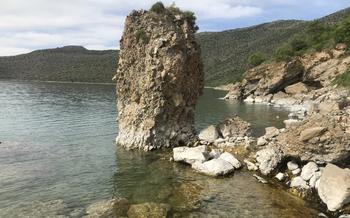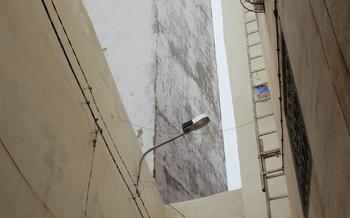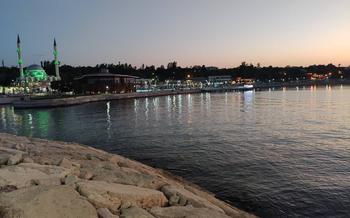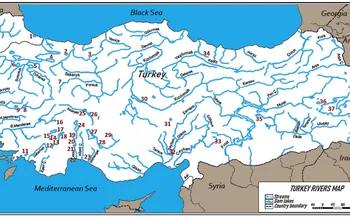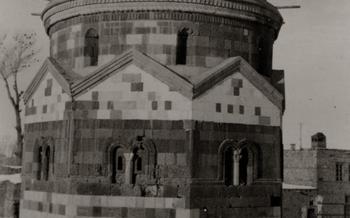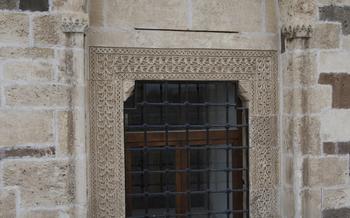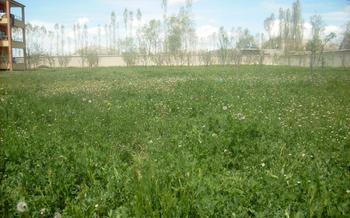
Selçuklu Caravanserai
- Van's Selçuklu Caravanserai: A Historical Gem
- Location and Getting There
- Hours of Operation and Admission Fees
- Exploring the Caravanserai's Interior
- Strolling Through the Courtyard
- Admire the Caravanserai's Architecture
- Discover the Caravanserai's Function
- Step Back in Time
- Capture Stunning Photographs
- Learn About Local History and Culture
- Enjoy a Break at the Caravanserai
- Plan a Day Trip from Van
- Check Out Nearby Attractions
- Respect Local Customs and Traditions:
- Insider Tip: Explore the Caravanserai at Sunset
Van's Selçuklu Caravanserai: A Historical Gem
Amidst the vibrant city of Van, a historical gem awaits exploration: the Selçuklu Caravanserai. This architectural masterpiece stands as a testament to the rich history of trade and travel along the Silk Road. Built in the 13th century by the Seljuk Turks, the caravanserai served as a resting place for merchants, travelers, and pilgrims traversing the ancient trade routes. Its strategic location, sturdy construction, and intricate design have ensured its survival throughout the centuries, making it one of the most well-preserved caravanserais in Turkey.
The Selçuklu Caravanserai is a prime example of Seljuk architecture, blending influences from Anatolian and Islamic traditions. Constructed from stone and brick, the caravanserai features intricate carvings, geometric patterns, and decorative tiles. Its imposing entrance gateway, framed by an elegant arch, leads visitors into a spacious courtyard surrounded by a series of vaulted chambers. These chambers once housed travelers and their goods, providing shelter, food, and water during their long journeys.
Beyond its function as a resting place, the caravanserai served as a vibrant center of trade and cultural exchange. Merchants from distant lands gathered here to exchange goods, share stories, and negotiate deals. The caravanserai also played a crucial role in the spread of Islam, as travelers from different cultures and religions mingled within its walls. Today, the Selçuklu Caravanserai stands as a silent witness to the bustling trade and cultural interactions that shaped the history of this region.
Location and Getting There
The Selçuklu Caravanserai is strategically situated in the city of Van, Turkey, at the crossroads of major trade routes. Its exact address is Mahmutpaşa Mahallesi Kazım Karabekir Caddesi No:10, Van Merkez/Van. To reach this historical gem, you can conveniently use the following GPS coordinates: 3479687, 43431
Multiple transportation options are available for travelers seeking to visit the caravanserai. For those arriving by air, Van Ferit Melen Airport (VAN) is the closest airport, located approximately 10 kilometers from the city center. From the airport, you can take a taxi or rent a car to reach the caravanserai.
If traveling by land, the caravanserai is easily accessible by bus or train. Van has a well-connected bus network, with regular services from major cities across Turkey. The train station in Van offers connections to various destinations within the country.
The Selçuklu Caravanserai is conveniently located within walking distance from the city center, making it easily accessible on foot. For those staying in nearby hotels or guesthouses, a leisurely stroll through the charming streets of Van will lead you to this architectural masterpiece.
Hours of Operation and Admission Fees
The Selçuklu Caravanserai is open to visitors every day of the week, offering ample opportunities to explore its grandeur. The gates swing open at 9:00 AM, inviting history enthusiasts and architecture buffs to step back in time. The doors remain open until 5:00 PM, allowing visitors to delve into the caravanserai's rich past at their own pace.
Admission fees are nominal, ensuring that everyone has the chance to experience this historical gem. A standard ticket costs 10 Turkish Lira, providing access to all areas of the caravanserai. Students and senior citizens can take advantage of discounted rates, paying only 5 Turkish Lira.
Guided tours are available for those who seek a deeper understanding of the caravanserai's history and significance. These tours are led by knowledgeable guides who bring the past to life, sharing fascinating stories and anecdotes. The cost of a guided tour is 20 Turkish Lira per person, offering excellent value for an immersive experience.
To avoid the crowds and ensure a more tranquil visit, plan your trip outside of peak season, which typically falls between July and August. During these months, the caravanserai may be bustling with tourists, making it challenging to fully appreciate its serene atmosphere.
Exploring the Caravanserai's Interior
As you step inside the caravanserai, you'll be greeted by a spacious and well-preserved interior. The layout is symmetrical, with a central courtyard surrounded by arcades on all four sides. Each arcade leads to a series of rooms and chambers, which were once used by travelers and merchants.
The architectural details of the caravanserai are exquisite, showcasing the skill and artistry of the Seljuk builders. The walls are adorned with intricate carvings and geometric patterns, while the ceilings are supported by elegant arches and vaults. The use of light and shadow creates a sense of depth and grandeur, adding to the overall beauty of the space.
The different spaces within the caravanserai served various purposes. The central courtyard was the main gathering area, where merchants would trade goods and socialize. The arcades provided shelter from the sun and rain, while the rooms and chambers offered privacy and comfort to travelers.
Throughout the caravanserai, you'll find artifacts and exhibits that tell the story of its history and significance. These include pottery shards, coins, and other objects that have been unearthed during archaeological excavations. By studying these artifacts, we can gain a deeper understanding of the daily life and activities that took place within the caravanserai.
Strolling Through the Courtyard
The central courtyard of the Selçuklu Caravanserai is an impressive sight, a large, open space surrounded by elegant arcades and iwans. The arcades feature pointed arches supported by slender columns, creating a rhythmic pattern that draws the eye. The iwans, or vaulted chambers, are located at the corners of the courtyard and provide shade and shelter from the elements. Each iwan is decorated with intricate carvings and colorful tiles, showcasing the artistic prowess of the Seljuk artisans.
The courtyard was the heart of the caravanserai, where merchants and travelers gathered to conduct business, exchange news, and socialize. It was a place of commerce and cultural interaction, where people from different backgrounds and regions came together to trade goods and ideas. The courtyards also served as a resting place for weary travelers, who could relax and refresh themselves before continuing their journey.
Traditional Turkish motifs and designs adorn the courtyard, reflecting the region's rich cultural heritage. Geometric patterns, floral motifs, and calligraphy inscriptions can be found throughout, adding a touch of elegance and beauty to the space. The courtyard is a testament to the architectural skill and artistic sensibilities of the Seljuk Turks, who created a space that was both functional and aesthetically pleasing.
Admire the Caravanserai's Architecture
The Selçuklu Caravanserai in Van showcases a captivating blend of Seljuk and Anatolian architectural styles. Built using sturdy stone and brick, its exterior is adorned with intricate carvings and geometric patterns. Decorative tiles, a hallmark of Seljuk architecture, add pops of color and elegance to the facade. The caravanserai's arched entrances, vaulted ceilings, and graceful iwans are testament to the skill and artistry of its builders. The harmony of these architectural elements creates a visually stunning ensemble that transports visitors back in time.
The intricate carvings and geometric patterns that embellish the caravanserai's exterior hold symbolic meanings. These decorative elements often incorporate motifs from nature, such as flowers, leaves, and animals, which represent fertility, abundance, and prosperity. Geometric patterns, with their precise lines and symmetry, symbolize order, balance, and the pursuit of perfection. The caravanserai's architecture is not merely decorative; it is a testament to the cultural and religious beliefs of the Seljuk Turks.
Discover the Caravanserai's Function
The Selçuklu Caravanserai, like many others along the Silk Road, served as a crucial hub for trade and cultural exchange. Its primary function was to provide a safe haven for weary travelers and merchants, offering shelter, food, and water to those traversing the vast trade routes. These caravanserai acted as resting places, allowing traders to replenish their supplies, tend to their animals, and connect with fellow travelers from distant lands.
Beyond providing basic necessities, the caravanserai facilitated the exchange of goods and ideas. Merchants from different regions brought their wares, creating a vibrant marketplace where diverse cultures converged. The caravanserai became a melting pot of languages, customs, and traditions, fostering a spirit of cooperation and understanding among traders from far and wide.
As a center of commerce, the caravanserai played a vital role in the economic prosperity of the region. It stimulated trade, encouraged the flow of goods and services, and contributed to the development of local economies. The caravanserai's strategic location along the Silk Road made it a key player in the exchange of valuable commodities, such as silk, spices, and precious metals.
More than just a place of rest and trade, the caravanserai also served as a symbol of hospitality and cultural exchange. It embodied the spirit of generosity and the importance of welcoming travelers with open arms. The caravanserai's architectural features, such as its spacious courtyards and iwans, were designed to create a welcoming and inclusive environment for people of all backgrounds.
Step Back in Time
As you explore the caravanserai, let your imagination transport you back to a bygone era. Picture the bustling atmosphere, with merchants from distant lands haggling over goods, weary travelers seeking shelter and sustenance, and the constant hum of activity. Imagine the vibrant energy of a place that was once a hub of trade and cultural exchange.
Feel the spirit of the Silk Road come alive as you wander through the caravanserai's courtyards and chambers. Imagine the stories that these walls could tell, of journeys undertaken, friendships forged, and dreams fulfilled. Let the history of this place wash over you, and experience the magic of a time when the world was a vast and interconnected tapestry of cultures and traditions.
Transport yourself back to the days when caravans of camels and donkeys laden with exotic goods traversed the vast expanse of the Silk Road. The Selçuklu Caravanserai stands as a testament to that era, a reminder of the rich history and cultural heritage that shaped this region.
Capture Stunning Photographs
The Selçuklu Caravanserai, with its imposing architecture and intricate details, is a photographer's dream. Whether you're an amateur or a seasoned pro, you'll find plenty of opportunities to capture stunning images here.
Start by exploring the exterior of the caravanserai. The main entrance, with its grand archway and decorative carvings, is a great place to begin. Capture the scale and majesty of the building against the backdrop of the surrounding landscape. Don't miss the intricate stonework and tilework that adorn the facade, as they add a unique character to the structure.
Once inside the caravanserai, your camera will be drawn to the central courtyard. The arcades and iwans that surround the courtyard create a beautiful symmetry, which can be captured from various angles. Look for interesting shadows and patterns that form as the sunlight filters through the arches. The intricate carvings on the columns and walls provide a wealth of detail to explore.
Don't forget to venture into the caravanserai's interior spaces. The rooms and chambers that once housed travelers and merchants offer a glimpse into the past. Capture the worn steps, the arched doorways, and the niches that line the walls. These details add depth and character to your photographs.
To capture the essence of the caravanserai, try to visit at different times of the day. The early morning light casts a warm glow on the stone walls, while the golden hues of sunset create a magical ambiance. Experiment with different angles and compositions to create unique and captivating images.
Remember to share your photos with others and inspire them to explore this hidden gem in Van. Your images can help preserve the memory of this historic caravanserai and showcase its beauty to the world.
Learn About Local History and Culture
In addition to its architectural significance, the Selçuklu Caravanserai offers a window into the rich history and culture of Van and the surrounding region. As you explore the caravanserai, take some time to learn about the Seljuk Turks, who ruled this area during the 11th and 12th centuries. Discover their contributions to art, architecture, and trade, and how they shaped the cultural heritage of the region.
The city of Van itself has a fascinating history, dating back to the ancient kingdom of Urartu. Explore the Van Museum to delve deeper into the region's past and uncover its many treasures. The museum houses a collection of artifacts, including cuneiform tablets, sculptures, and jewelry, that provide insights into the lives and customs of the region's ancient inhabitants.
Moreover, the caravanserai's location along the Silk Road made it a melting pot of cultures and traditions. Merchants and travelers from far-off lands passed through its gates, bringing with them their own unique customs and beliefs. As you wander through the caravanserai, imagine the vibrant atmosphere of the past, where people from different corners of the world came together to exchange goods, ideas, and stories.
Enjoy a Break at the Caravanserai
After exploring the captivating interiors and exteriors of the caravanserai, take a moment to relax and soak in the tranquil atmosphere. Settle into the serenity of the central courtyard or find a shady spot beneath the lush trees surrounding the caravanserai. Indulge in a cup of Turkish coffee or tea, savoring the rich flavors and aromas as you let the echoes of history wash over you. Take a leisurely stroll along the nearby streets, observing the vibrant local life and absorbing the charm of the neighborhood. Engage with the friendly locals, who will gladly share stories and insights about the caravanserai and their beloved city. Embrace the warmth and hospitality that Van is renowned for, and make the most of your visit by immersing yourself in the authentic local experiences.
Plan a Day Trip from Van
Incorporate the caravanserai visit into a broader exploration of Van and its surroundings. Combine history and nature by visiting the imposing Van Castle, a testament to the region's rich past. Immerse yourself in the local culture at the vibrant Van Bazaar, a shopper's paradise brimming with traditional handicrafts and souvenirs. For a breathtaking natural experience, embark on a boat tour of Lake Van, the largest lake in Turkey, and marvel at its crystal-clear waters and stunning scenery. With so much to see and do, a day trip from Van promises an unforgettable journey through history, culture, and natural wonders.
Check Out Nearby Attractions
Van's Selçuklu Caravanserai is just one of the many fascinating attractions in the region. Take this opportunity to explore some of the other must-see places nearby:
-
Van Museum: Immerse yourself in the rich history and culture of Van and its surroundings at this comprehensive museum. Discover ancient artifacts, traditional costumes, and exhibits showcasing the region's diverse heritage.
-
Van Bazaar: Experience the vibrant atmosphere of a traditional Turkish bazaar, where you can bargain for unique handicrafts, carpets, jewelry, and souvenirs. Mingle with locals and soak up the bustling energy of this lively marketplace.
-
Boat Tour of Lake Van: Embark on a scenic boat tour of Lake Van, the largest soda lake in the world. Marvel at the stunning turquoise waters, picturesque islands, and majestic mountains that surround the lake. Keep an eye out for the unique wildlife, including the famous Van cats with their distinctive eye colors.
-
Hidden Gems and Off-the-Beaten-Path Experiences: Venture beyond the main tourist attractions and discover hidden gems that offer a glimpse into the authentic local culture. Explore charming villages, visit historical sites, and indulge in culinary delights that showcase the region's unique flavors. Ask locals for recommendations or do some research to uncover these hidden treasures.
Respect Local Customs and Traditions:
When visiting Turkey, it's essential to be mindful of local customs and traditions to ensure a respectful and enjoyable experience. Dress modestly, especially when visiting religious sites like mosques. Refrain from wearing revealing clothing or shorts as a sign of respect for the local culture. Be aware of your body language and gestures, as certain actions may be considered inappropriate or offensive. Ask permission before taking photos of people, as it's considered polite to obtain consent. Remember that Turkey is a Muslim-majority country, so respecting local customs and etiquette will help you better understand and appreciate the culture. Embrace the opportunity to learn about local traditions and customs, as they play a vital role in shaping the unique identity of the region. By showing respect and appreciation for the local culture, you'll create a positive and meaningful connection with the people you encounter during your travels.
Insider Tip: Explore the Caravanserai at Sunset
To truly experience the magic of the Selçuklu Caravanserai, visit it as the sun begins to set. The warm, golden light casts a beautiful glow on the caravanserai's stone walls and intricate carvings, creating an enchanting atmosphere. Take your time to explore the courtyard and admire the architectural details as the sky transforms into a canvas of vibrant colors. Capture breathtaking photos that will forever remind you of this special moment. As the sun dips below the horizon, find a peaceful spot in the courtyard to soak in the serene and tranquil ambiance. This is the perfect time to reflect on the history of this ancient caravanserai and the many stories it holds.
